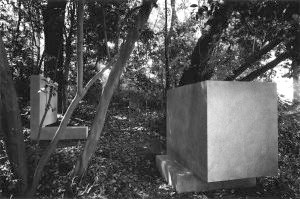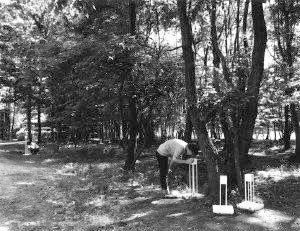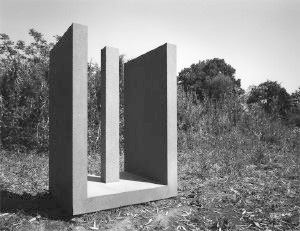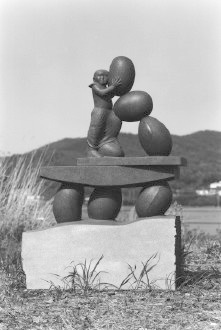
Copper, Pebbles, Steel
150×150×200 cm
400 kg

Copper, Pebbles, Steel
150×150×200 cm
400 kg

White granite, Iron
380×220×250 cm
700 kg
Spring in Yamato Village is just beautiful. Every time I visit, I think again “can there really be this many kinds of green?” Within the copses that are everywhere in this village, I created my works with the white marble that is everywhere in this village. When I cut back the undergrowth on the installation site, a Japanese bird cherry sapling grew up, so I decided to incorporate it into my work.

Cloth
320×130×150 cm
420×150×120 cm
The two cars next to the approach path to Hakusan shrine bothered me, but they seemed to have some kind of connection with the place. It looked like someone had made an offering of a rusted car with broken glass and a red compact car that looked ready to go any time. Even so, they bothered me, and therefore, I decided to hide them and make them secret. It seems that, for some things, the more you conceal them, the more something about them remains in view.

White granite
60×150×230 cm
1800 kg

Steel
12.5-31.25×25-37.5×250 cm (×9P)
90 kg (×9P)
I still remember the amazement I felt one afternoon in the summer of last year when I discovered this deep bamboo grove. I wander through the bamboo grove, and from time to time, I just stop for a while, amid the solemn air and the light that pours down from above. I will erect nine pillar forms in this grove, each consisting of three rectangular steel sections. That resembles the motions of placing my own body among the bamboo. In the time and space of wandering through the grove, the will of the steel, which is the form and material I shaped, slips in and out of view.

Iron (Alumite Plating), Wire rope, Winch, Concrete, Stone
800×2000×600 cm
10 t
My sculpture takes reverence for nature as its spiritual support, and is based on the beauty of the mechanical structure between spatial tension and an instant of halted time.
This bridge continues to point in the direction to the earth’s axis.

Cloth, Iron and the others
60×190×170 cm 60 kg
90×120×168 cm 50 kg
60×90×136 cm 40 kg
I’m filled with gratitude to the many people who have worked with me in all stages, from planning to installation. Thank you all very much indeed.
Creative collaborators:
HONGO Megumi, KIUCHI Ayako, SEKIGUCHI Junko, KURASHIGE Hiromi, KITO Mariko and HASEGAWA Yumi.

A site of Stone factory, Natural stone, Water paint
770×567×80 cm
1500 kg (2 Natural stones)

White granite
350×350×20 cm
220×80×45 cm
I planted moss in the holes that were originally made to split the white marble. Moss uses the dew for nutrition to grow. The blocks of stone, laid flat, represent droplets of water from the dew. Things with tangible form can be seen, and those without form cannot, but the dew belongs to neither group, and I took that as my theme.

Deserted boat, FRP, Paint, Cloth, Steel, Stainless steel
350×160×320 cm
250 kg
Until now, I’ve kept on making big, heavy sculptures for a long time. In a way, that is my taste, but it’s also the way I work. Nevertheless, it may not be necessary to have size and massive presence to cover some of the themes of my work, which are “Things that can’t be captured in a photo or drawn in a picture”, “Things that can’t be created from a concept alone” and “Things which change the atmosphere of the of the place they stand in”. So, for the last five years I’ve been working simultaneously on very small pieces and pieces which aggressively engage the gallery space. What I’m trying this time at Amabiki Village is of the latter type. I have a renewed sense of the pleasure of feeling and thinking about site-specific “pieces which can only be done here and now”.

Black granite
90×100×110 cm
3000 kg

Aluminum, Stone, Lens, The positive film taken by IZAWA Masana
30×30×30-90 cm (×17P)
Since last year I have built a device to show IZAWA Masana’s photographs of molds, mushrooms and mosses in an enjoyable way, and I have presented it at elementary schools, mycology seminars, art exhibitions, museums and elsewhere. Now I look forward to showing the people of Amabiki, and the visitors to the Second Amabiki Village and Sculpture, the photographs of moss and mushrooms that IZAWA took in the course of six months of fieldwork.

Black granite, Concrete, Iron
140×30×36 cm (×2P)
400 kg, 360 kg
Coexistence annulus
Black granite, Concrete, Iron
63.5×150×150 cm
1750 kg
When I visited this wood before, looking for a site, it was much denser and harder to move around in. With the undergrowth cut back after the end of winter, the wood is much less dense, and it is easy to look across the little shrine in the center. It is also possible to measure the passage of time. Similarly, the created works seem to soak up the amount of time you spend moving among them. I think that is the source of their gravity, as distinct from their weight.

Granite
70×60×180 cm
800 kg

White granite
70×70×215 cm
1700 kg

Ceramics
120×120×120 cm
260 kg

Granite
95×220×175 cm
1200 kg

Iron
151×190×152 cm 2000 kg
152×304×6 cm 1000 kg

Ceramics
150×150×340 cm
700 kg

Black granite
81×86×127 cm
1000 kg
I end up stripping the stone naked. I can be delighted as I peel away a layer at a time. But it can also be good to just rip it all off. Some stones are shy, some want to undress themselves. Depending on how you do it, you may be disappointed, or you may think, “Wow!” Whichever approach you take, start with a little flirting.
* “II” in the art work name means the second of the Roman numerals.

Kiri wood
250×250×60 cm
120×120×40 cm, and others
I found a grove that the sun penetrated into. I put together some boards I was carrying and thought about the image of circulating water. Departing from the usual forms, I continued this work up to the time of placement, and even now I’m arguing with myself about how to interact with this setting.





POSITION (unit, crust)
White granite, Acrylic paint
86×194.5×45.86 cm_1200 kg
86×33×220 cm_900 kg
30×25×350 cm_50 kg
Coloring sculptures and buildings has existed as an occupation since ancient times, but I believe adding arbitrary colors to surfaces as the form, material and texture of sculpture is far from making sculpture sublime by cutting away all that is superfluous.
While I am aware that these works are probably expressions of my own vagueness, in an environment that changes intensely, from winter desolation to the beginning of spring, I could not bear the obvious confrontation of the sculpture alone being an immobile and unchanging presence.
Inside me, everything I thought I had sculpted until now transformed into an extension of canvas from the first touch of the brush.


Bronze
2000×90×200 cm
300 kg
It has been 25 years since I started casting basic forms with my own hands, and I still fail repeatedly. But there are times when failure shows me the beginnings of new forms, and my work brings me fresh surprises. The work I’m exhibiting approaches a theme I’ve been pursuing in recent years-putting the image of machines on the human body.

Log, Brick, Rubber tube
1100×1100×250 cm
2000 kg
Walking around the rice-growing area of Amabiki Village, one becomes aware that water is a gift that spins into life.
The moment I saw the reservoir pool with Mt. Tsukuba behind it, I wanted to float my work there, like a flowering lotus.
I wanted to create a work that, like a lotus, would represent the invisible cosmos between this world and the world beyond, the resting place.
I wanted to see it with my own eyes and make it part of the scenery of Amabiki.

Wood, Fluorescent paint, Natural light
300×300×480 cm
There are some moments in daily life when you re-recognize the presence of light that fills space. Light is noticed when it touches something, but I wanted to take the light that must exist between the source and the thing it falls on, and make it tangible. This is a device that gathers the natural light that pours down by day, and subtly emits light when darkness falls. It presents an experience of light.

Sandstone
60×60×160 cm
400 kg

Brass
230×190×60 25kg
170×180×65 20kg
80×190×150 20kg

Corten steel, Wood, Burner
500×25×25 cm
150 kg
A wind blows gently through the precincts of Takaku shrine in Amabiki Village. It now sleeps peacefully, leaving traces of past glory. That must be a gentle wind, like one in a memory. Sometimes it is a fiercely raging wind. A wind that is moved to tears. A wind that laughs. The color of the wind of ancient times is faintly visible. The color of the wind is in the middle of a memory.

Black granite
51×82×126 cm
800 kg
In many ways people can be performing some kind of act of austerity. Indian ascetics, monks and the like are famous for that, but perhaps giving up drinking or stop smoking are other forms of austerity. I gave form to the image of people who recited sutras in front of my house when I was a child, and who now stand in front of stations and similar places for their austere devotions.

White granite
360×700×25 cm
5000 kg

Black granite
120×150×92 cm
700 kg
Envisaging a large stone split into eight pieces, a composition of faces which did not previously exist is formed inside the original stone. That exists in the mind’s eye, but cannot be seen in its concreteness. Adding thickness to that form, I tried to carve it from one raw stone. Asking what it would be like if I added some holes to those faces, I arrived at my current piece of work.

Black granite
100×330×20 cm
Carved own weight of each stones on face
These are weight-stones for measuring the weight of the Earth. I think it might serve as an opportunity to imagine this globe that I’m standing on. If I made many pieces like this, would they give a feeling of the weight of the Earth? Sometimes I try thinking about foolish things like that. Earth is drawn to this stone by gravity, which made me notice that all objects in everyday life are in the same kind of relationship.
But if I make too many, the weights themselves would become the world next…

Akagikomatsu-ishi (Andesite)
85×320×120 cm
1800 kg

Granite
215×150×92 cm
4000 kg

Black granite
60×150×213 cm
1800 kg

Black granite
130×190×190 cm
3500 kg

Wood (Zelkova tree, Japanese cypress, Crape myrtle)
300×340×370 cm
2000 kg
The trees I used in my work were crape myrtle from Oshima, zelkova from Fukushima and sawara cypress from Ibaraki. Each type is a giant tree, centuries old, and they had finished their labors in their different regions. Combining and assembling them gave birth to a new tree from trees. If they all had decayed, they will return to the refined stage of a tree. I think that I have done an extra thing again.

Aluminum, Japanese paper
The mushroom-grower’s hut was born within the flow of the economy, and its role ended with the end of that economy, leaving it to crumble. For a moment in the span of time before it disappears, my use of it in a work of art added to the history of the hut. This was meaningful for me. A seashell is a nest that once had life within it, growing over a long period, and while it went on living, it kept changing as proof of that life. Maybe my work is another husk of life.

Aqua Tower
Water, Plastic bottle, Iron
540×540×560 cm
2800 kg

Cloth, Water
100×20 m
Thinking and thanking to the earth filled with clear and plentifull water, we made 2 artworks.
And Also pray for a beautiful days of life forever.
Members of Group · RA:
AOKI Saori, AKUTSU Etsuko, IIJIMA Masami, IKEDA Kazuko, IKEDA Fumiaki, ICHIHARA Kazuko, OGURA Takao, KATORI Tadashi, KAWASHIMA Aki, KAWASHIMA Shoichi, KAWAMATA Kunio, KOMINE Aki, KOMINE Takashi, SAJI Masahiro, SATO Toshie, SATO Tomomi, SATO Yasumasa, SEI Michihumi, SUZUKI Kouichi, SUZUKI Masae, TASAKI Shizue, TAKEKOSHI Hidekazu, TOMIYAMA Shinichi, TOMOYAMA Narumi, TOMIYAMA Ria, NAKAZAWA Fumio, NOMURA Masahumi, FUJITA Ikuyo, FUJITA Nozomi, BUNGO Ryota, MASUBUCHI Chieko, MACHI Kiiko, YASUDA Yukio, and Roland SASCE.
Cooperators:
Amabiki Elementary School, Ohkuni Elementary School, Yamato Junior High School, Friends of Matsudo, Friends of Nakano, AKIMOTO Tadataka, AKIMOTO Toki, AKENO Re-cycling Co., IWASAKI Electric Co. Ltd., EGAWA Wakako, OHNUKI Kouichi, OHYAMA Shop, JOUYOU Machinery Co. Ltd., SUMIHATSU Co. Ltd., DYSTAR Co. Ltd., TAGUCHI Construction Co. Ltd., TORAY Co. Ltd., HOSAKA Yukichi, MUNAKATA Toshiaki, YAGAWA Genichiro, and YOSHIDA Toshikazu.